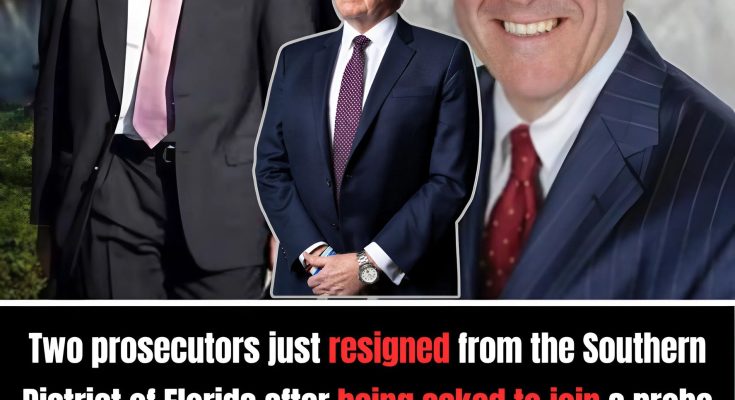
The headlines hit Washington like a thunderclap:
“BREAKING SHOCKWAVE: DEEP STATE IN MELTDOWN.”
For years, the phrase Trump-Russia 2016 had hovered like a ghost over American politics — whispered in corridors of power, shouted across TV panels, wielded as both sword and shield in a bitter war of narratives. But this time, it wasn’t another rumor. It was real, and it was official.
Two senior federal prosecutors from the Southern District of Florida had abruptly resigned after being asked to join a newly revived investigation into what’s now being called the “Russia Hoax Probe.”
They didn’t give statements. No farewell press conference. Just quiet exits — within hours of receiving the assignment.
To the political class, that silence spoke louder than words.

The Revival
The origins of this investigation stretch back nearly a decade — to one of the most divisive political sagas in modern history. The original Trump-Russia probe, launched under the Obama administration, claimed to investigate alleged ties between the Trump campaign and Russian operatives during the 2016 election. It dominated headlines, fueled the Mueller Report, and divided the nation.
But now, new evidence had surfaced — internal memos, redacted communications, and testimony that suggested the investigation itself had been built on manipulation, misinformation, and deliberate deceit.
“Everything they accused Trump of,” said one senior intelligence source, “they were doing themselves.”
When the Justice Department quietly reopened the case earlier this month, insiders called it “the most dangerous internal audit in modern American history.”
According to leaked memos, the investigation’s scope is massive: dozens of subpoenas, new witness interviews, and a full review of intelligence procedures dating back to 2015. The names circulating are explosive — John Brennan, former CIA Director, James Clapper, former Director of National Intelligence, and Andrew McCabe, the ex-FBI deputy director fired under a cloud of controversy.
And this time, it’s not Trump under the microscope. It’s the people who tried to destroy him.
The Resignations
The first shock came on a Wednesday morning. Federal Prosecutor Rachel Kline, a veteran with two decades at the Justice Department, turned in her resignation letter without warning. Hours later, her colleague David Cernovich did the same.
Both had been summoned to join the revived Trump-Russia review team, but according to sources close to the case, neither wanted to be “part of something that could rewrite history.”
Their departures were described by one insider as “a quiet panic spreading through the ranks.”
“These people know what’s in those files,” the source said. “They know how deep it goes.”
The Justice Department declined to comment, but their resignations set off an earthquake of speculation: What exactly are they afraid of?

The Target List
A confidential memo leaked to independent journalists revealed the first round of subpoenas — more than forty in total. Among them, one name stood out in bold: John Brennan.
Brennan, who ran the CIA during the Obama administration, was long accused by Trump allies of orchestrating the early intelligence narrative that tied Trump’s campaign to Russian operatives. For years, Brennan dismissed those accusations as “baseless conspiracy theories.”
But according to one DOJ official, new communications have surfaced — emails and classified briefings showing Brennan may have personally approved the use of unverified foreign intelligence in FISA warrant applications.
“If that’s true,” said a retired federal judge, “it’s not just misconduct — it’s treasonous manipulation of America’s security apparatus for political gain.”
When reporters reached out to Brennan’s office for comment, they received only a terse statement: “Mr. Brennan stands by his record of service to the nation.”
But within intelligence circles, panic was rising.
One former FBI official reportedly told a colleague, “If Brennan goes down, half of Langley goes with him.”
The Domino Effect
The revived probe, sources say, is being led by a hand-picked team of prosecutors known for their independence and resilience — the kind of officials who don’t bend easily to political pressure.
And they’re moving fast.
“Dozens of subpoenas are already out,” one Justice insider confirmed. “They’re not starting from scratch. They already know where the bodies are buried.”
That phrase — where the bodies are buried — has since become a rallying cry on social media. Conservative commentators are calling it “the reckoning,” while mainstream outlets have cautiously begun using the phrase “historic accountability.”
It’s not just rhetoric. The implications are massive.
If evidence proves that elements within the U.S. intelligence community knowingly manipulated data, fabricated evidence, or misled courts to justify spying on an American presidential campaign, it would represent the single largest breach of trust in the history of the republic.
And this time, the trail doesn’t lead to Trump. It leads to those who built the case against him.
The Panic
Behind closed doors, Washington is in crisis mode.
Former officials are lawyering up. Congressional allies are demanding immunity. National security agencies are scrambling to review internal files before subpoenas arrive.
According to one insider from the Department of Justice, “The mood right now is pure fear. Everyone’s trying to figure out what’s about to drop — and who’s going down first.”
Even within the media, cracks are showing. Several prominent journalists who once pushed the Trump-Russia narrative have quietly revised past articles, adding disclaimers or removing certain claims that relied on anonymous intelligence sources.
“It’s not about ideology anymore,” one reporter admitted. “It’s about survival.”
The White House Reaction
When asked about the resignations and subpoenas, Vice President JD Vance didn’t mince words.
“For years, they called it a conspiracy theory. Now, the conspiracy’s being proven in real time,” he said. “This is what happens when you weaponize the government against the people. Eventually, the truth breaks through.”
Sources close to the Trump team say the former President has been briefed on the developments and is “energized” by the turn of events. “He’s been waiting for this day,” one aide told reporters. “He always said it would come — and now it’s here.”
The Bigger Picture
Political analysts warn that the investigation could reshape American politics for decades. If prosecutors uncover evidence that top intelligence figures coordinated politically motivated operations against a presidential campaign, it would expose a rot far deeper than partisan politics — it would reveal a government at war with itself.
And that’s exactly what appears to be happening.
Documents reportedly show that internal warnings were ignored in 2016, dissenting voices silenced, and fabricated “intel summaries” pushed to justify surveillance orders. The deeper investigators dig, the more systemic it looks.
One senior law enforcement official described it bluntly:
“This wasn’t an accident. It was a coup — dressed up as patriotism.”
The Reckoning
The public reaction has been explosive. Social media erupted with calls for full transparency, trials, and public hearings. Hashtags like #BrennanSubpoenaed and #DeepStateCollapse trended globally.
At the same time, the usual defenders have gone silent. Former Obama officials have declined interviews. CNN and MSNBC have been unusually muted. The silence, to many, feels like confirmation.
“The era of untouchables,” one political commentator said, “is finally over.”
But as investigators push forward, questions remain: how far will this go? Who will testify? Who will turn?
And perhaps most importantly — what will happen when the truth, whatever it is, finally comes out?
For now, Washington trembles.
Two resignations. Dozens of subpoenas. One name — John Brennan — at the center of the storm.
After years of secrets, leaks, and lies, the tables are turning.
And this time, it’s the Deep State that’s under investigation.



